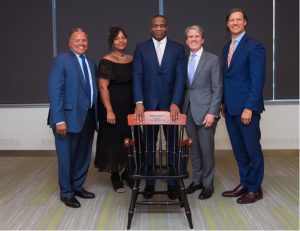By Daniel Dunaief
Stony Brook University named physician-scientist Dr. Imoigele “Imo” Aisiku as chair of the Department of Emergency Medicine at the Renaissance School of Medicine, starting Aug. 15.
A national leader who has dedicated his career to critical care and neurocritical care in emergency medicine, Aisiku worked for more than a decade at Brigham and Women’s Hospital and Harvard Medical School.
Aisiku, who was born in Nigeria and raised in Brooklyn and Auburn, Massachusetts, found several factors appealing about the Stony Brook role.
“My immediate family is predominantly in the Northeast” stretching from New York to Richmond, Virginia,” he said. Additionally, he suggested that numerous aspects of the role were “right in my area of expertise.”
His experience at Brigham and Women’s Hospital involved integrating systems, and he recognizes the opportunity to deploy that skill set at Stony Brook, where he will help integrate the emergency department at different hospitals.
He also has considerable experience in critical care, which is a strength at SBU.
“There are some natural synergies that you couldn’t script” he added, including strong clinical interest in stroke, telehealth, critical care and a desire to develop a systems integration model
Indeed, before he came to Brigham and Women’s Hospital, Aisiku worked at the University of Texas at Houston. UT Houston/Memorial Hermann was one of the earliest to be named a JCAHO Comprehensive Stroke Center.
Aisiku was the medical director of their neurosurgery intensive care unit, which had one of the first mobile stroke units in the country. The unit was a collaboration between EMS, neurology, the stroke division, EM and the ICU.
A mobile stroke unit can provide critical and timely diagnostics and care for people having a stroke, which can not only save lives but can also lead to a dramatic improvement in the outcome after a stroke event for patients.
Stony Brook currently has two mobile stroke units and is working on adding a third.
“I hope to leverage what is the strength of Stony Brook with my experiences” and strengthen any weaknesses in a bidirectional manner, said Aisiku, who will report to Peter Igarashi, dean of the Renaissance School of Medicine.
For his part, Igarashi was eager to welcome the new addition to the emergency department.
“We are thrilled that Dr. Aisiku will lead Stony Brook’s remarkable team of emergency physicians,” Igarashi said in a statement. “As a pioneering physician-scientist in neurocritical care, and as an emergency medicine scholar and researcher, Dr. Aisiku will help advance our capacity to save lives and care for critically ill patients in the years to come.”
Evolutionary change
The new emergency department chair is hoping to learn more about Stony Brook’s strengths and weaknesses before implementing any changes.
“I hope to make a change and a difference,” Aisiku explained in an email. “I believe it is prudent to aim for evolutionary change and, if there is an opportunity, for positive revolutionary change.”
His goal is to see the department grow from a regional strength to a national and even an international strength.
He plans to develop partnerships with other chairs and departments and hopes to enhance programmatic and faculty development.
Aisiku also hopes to develop opportunities for faculty at Stony Brook, including in areas that involve research. He would like to see the department earn more National Institutes of Health and federal funding.
DEI experience
An accomplished physician, researcher and administrator, Aisiku also has considerable experience building and encouraging opportunities for underrepresented groups in medicine.
Aisiku was the founder and director of the Offices of IDEaS, which stands for Inclusion, Diversity, Equity and Social Justice, in Emergency Medicine at Brigham and Women’s Hospital, where he credits a team of faculty administrative staff and supportive chair for the success of that effort.
Aisiku “played a crucial role in the development of the office of IDEaS,” Jayelani Hall, administrative manager for Emergency Medicine and the Office of IDEaS at Brigham and Women’s Hospital, explained in an email. Aisiku’s vision for creating an inclusive environment and commitment to equity and diversity were “instrumental in shaping the initiatives and programs that define IDEaS today.”
IDEaS has launched several initiatives, such as the Profile in Diversity Series and the SPAK Grant program, which provides funding to projects that advance diversity, equity and inclusion.
The office established scholarship programs to support underrepresented students pursuing careers in medicine and health care, Hall added.
The president of Brigham and Women’s Hospital named Aisiku endowed Distinguished Chair in Health Equity and Diversity.
The broader Stony Brook area extending to New York City “draws diverse and international people to the region,” Aisiku explained. “While I acknowledge that [DEI] is an area of controversy in our country, I believe continuing to strive for diversity has a significant role for the development of our youth all the way to impacting our patients.”
In speaking with the leadership of the hospital and medical school, Aisiku believes his diversity goals are “aligned in these efforts” as he looks forward to developing strategies that will lead to diverse students, residents and faculty.
In addition to providing opportunities to students in the health care field, a more diverse population of caregivers enhances the patient experience, Aisiku contends.
A diverse health care force provides greater opportunity for patient choice and advocacy, he added.
Aisiku, who has master’s degrees in business administration from Goizueta School of Business and a master’s in clinical research from Rollings School of Public Health at Emory University, would like to partner with the business school and the school of public health, among others, to build diversity, which may broaden and enhance his efforts in this area.
People who have worked with Aisiku appreciate his commitment and openness to those around him.
Aisiku is “known for his compassion and dedication both as a physician and as a leader,” Hall wrote. “He consistently goes above and beyond to ensure that his patients receive the best care possible and his commitment to equity in health care is evident in all his endeavors.”
Hall suggested that the Stony Brook community is fortunate to have Aisiku in this role.
“Given his track record, I fully expect him to engage deeply with students, faculty and community members, fostering connections and driving positive change,” Hall explained.

Telehealth experience
Over a decade ago, Aisiku started iDoc Telehealth Solutions, a telemedicine company dedicated to critical and neurocritical care and tele-stroke services, with the goal of providing this type of care to people in areas that didn’t have enough clinicians with that experience.
Since then, he has become co-CEO of a public company called VSEE Health.
He expects to pass the torch on to other executives. His commitment is to the university as his obligation to the company is for about four more months.
To be sure, he wants to ensure there are no conflicts of interest in his roles at Stony Brook and in the decision about how and in what ways the university can continue to build telehealth capacity.
“If there is an opportunity to enhance an area, with full disclosure, there can be pathways to achieve things that improve the patient experience while separating ‘church’ and ‘state’ so to speak,” he explained in an email.
Morana Lasic, interim chief diversity & inclusion officer at Brigham and Women’s Hospital, suggested that Aisiku has served as a personal and institutional resource for a wide range of people.
Aisiku “works with those who are yet to enter the medical field and need mentorship, just as he does with institution presidents,” Lasic explained in an email. “He empowers those on his team and pays special attention to those who are often forgotten in mentorship (such as young administrative staff.)”
Lasic added that Aisiku was generous with his time and has reached out to her with emails and new thoughts and ideas at any time of day.
“Just like the rest of his life, his sleeping schedule is unique and his own, and he wears an Oura ring (which tracks sleep patterns) just to confuse it,” Lasic said.
In his research, Aisiku has focused on three areas: traumatic brain injury, subarachnoid hemorrhages and acute respiratory distress syndrome/sepsis.
Aisiku is living with his wife Diana, who is a nurse, and their 4 1/2-year-old son Myles in Westbury. They are in the process of searching for a home.
Outside of work, Aisiku has a black belt in the martial art of Jeet Kune Do, enjoys working out and played Division 3 tennis and basketball, at Worcester State University. He is also a motorcycle enthusiast.
As for his likely contribution to the Stony Brook community, Lasic, who has been at Brigham and Women’s Hospital for 25 years, suggested that she anticipated he would continue on an impressive journey.
Aisiku is “one of the most innovative leaders in academic medicine I have seen in a long time,” she wrote. “He is a true role model in his ability to connect with those around him.”



















